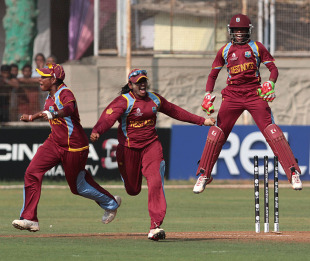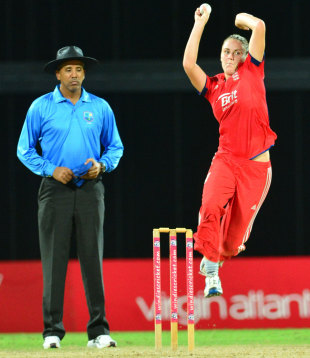Ireland are undoubtedly masters among the minnows but they continued to be disappointed at not getting chances against the big boys
Ger Siggins December 30, 2013

Ireland's domination of the Associate level is complete. Now they yearn for Test status © ICC/Saleem Sanghati
It may just have been Irish cricket's greatest year ever. Qualification was secured for the 2014 World Twenty20 (men and women) and the 2015 Cricket World Cup, and the senior men finished the year by completing the clean sweep of global Associate trophies in all three formats. But it rankles with the players that they failed to drive home victories in three games when they had Full Members on the rack, for it is against those opponents that they now measure themselves.
Their domination of Associate level is complete; despite an impressive emergence, Afghanistan are still no match - Ireland's margins of victory in their three most recent games against them in descending order of format is 122 runs, 59 runs and 68 runs.
Since the Caribbean breakthrough in 2007, Ireland have lost just 11 out of 107 games against fellow Associates. In the Intercontinental Cup they have lost just once in 20 games, and their record in limited-overs cricket is overwhelming. In 50-overs cricket they have won 43 out of 50, plus one tie, and their T20 record is 32-4, with just one defeat in 24 games since 2010.
Cricket Ireland has complained of the lack of opportunity to test their team against the best sides, and 2013 was again a disappointment on that score. Just three ODIs were granted, all in Dublin, but on each occasion the Irish were on top for long periods.
In May, Pakistan came for a two-game series, and escaped with a 1-0 win. In the first, the visitors racked up 266 for 5 but Paul Stirling scored a brilliant century - his second in succession against Pakistan - and Kevin O'Brien a typically barnstorming 84 off 47 balls, including a four off the last ball from Ajmal to secure a tie. Ireland switched pitches for the second game two days later, banking on a greener track to negate the Pakistan spinners. The €7,000 bill for moving the scaffolding and grandstands looked money well spent until the last ten overs.
Ed Joyce made three figures in an ODI for Ireland for the first time (joining Eoin Morgan as the only pair to do so for two countries) but the total of 229 looked inadequate until Trent Johnston and Tim Murtagh reduced Pakistan to 17 for 4. But both Misbah-ul-Haq and Shoaib Malik were dropped before they had scored, costing the initiative - and 67 runs - and Kamran Akmal came in and blitzed 84 to secure a two-wicket win with eight balls to spare.
" Frustrated with the ICC's resistance over providing a road map to Test status, Cricket Ireland has written its own plan and commenced an ambitious three-team, three-format inter-provincial series
The third ODI, against England, saw the opening of the new pop-up stadium in Malahide, when an unseasonably hot, sunny day brought the biggest crowd ever seen at an Irish game to the Dublin venue. It was a match that enthralled the watchers, and a live TV audience. It also impressed ICC Global Development manager Tim Anderson: "10,000 people in Dublin on a Tuesday afternoon suggests this is becoming a very serious cricket market," he said. "There is a growing culture of cricket in this country." As Cricket Ireland's Warren Deutrom points out, "Words like 'market' and 'culture' are very important in the ICC lexicon."
It was a game that was riddled with issues of identity that perplexed the casual observer and infuriated the partisan. Both captains were Irish, and both made centuries - William Porterfield's ended by his old Strabane Grammar school-mate Boyd Rankin. In fact both Rankin (4 for 46) and Morgan (124 not out) made their career bests in ODIs, as England exacted revenge for the defeat in Bangalore in the 2011 World Cup. Ireland made 269 for 7 and an opening burst by London-Irish Tim Murtagh (3 for 33) reduced England to 48 for 4. But Morgan found a partner in Ravi Bopara (101 not out) and their unbroken 226 stand was decisive.
Ireland's only other defeat in the 24-game programme came when an Australia A side came to Stormont, chiefly to give its Ashes bowling attack a run-out while the ODI series was in progress in England. Stirling was the only county player available, and made a fine hundred, while seamer Max Sorensen (5 for 50) and third-choice wicketkeeper Stuart Poynter (63) took their chances.
Frustrated with the ICC's resistance over providing a road map to Test status, Cricket Ireland has written its own plan and commenced an ambitious three-team, three-format inter-provincial series between Leinster Lightning, Northern Knights and North-West Warriors. The Leinster side, based in Dublin, was the strongest, but was pipped to the 50-overs title by the Knights.
Despite this innovation, English counties remain the most attractive route for ambitious youngsters, and Poynter ended the summer with a 2014 contract for Durham, while allrounder Andrew Balbirnie extended his deal at Middlesex and Jack Tector caught the eye of Glamorgan.

An Ireland supporter spoke for many during their ODI against England in Malahide © Getty Images
Qualification for the 2015 World Cup was secured in Amstelveen in July, and a 100% record at the T20 qualifiers ensured Ireland were placed in the less-challenging group at the first round in the World Twenty20 in Bangladesh. The season finished with a titanic five-day battle with Afghanistan just outside the ICC offices in Dubai, where epic individual tussles punctuated long periods of attrition as the sides struggled to assert supremacy. Eventually Ireland pulled away, the bludgeon of the second new ball breaking the Afghans' will in what was a Test match in all but name.
That game saw the retirement of Trent Johnston, and although his No. 23 shirt will be impossible to fill, coach Phil Simmons has not been idle in succession planning. A series of young seamers has been blooded, and three sent to Brisbane for the winter to work with Craig McDermott. An A tour to Sri Lanka in January, and the senior side joining the West Indies domestic Super50 will further aid the process.
High point
In a year of on-field high points, the opening of Malahide will probably be seen as the most important event. In coming years, permanent structures will be added, but the visit of England proved there was a 10,000-plus audience for the game on a Tuesday in September.
Low point
It may seem greedy but the failure to mark the opening of Malahide with a win over England was disappointing. That it took career bests by ex-Malahide player Morgan and fellow Irishman Rankin added to the pain for home fans.
New kid on the block
It has been a difficult couple of years battling against his own body for Craig Young. The Bready seamer has been at Sussex for four seasons but stress fractures to hip and back have meant he has yet to break into the first XI. Hearteningly, there were promising signs towards the end of the summer when he also made his international debut against Scotland, taking 4 for 53 and 2 for 57.
"Craig bowls decent pace - 82-83mph - and swings the ball naturally," says his county captain Ed Joyce. "He's also extremely strong so can bowl long spells when fit. I've also rarely seen someone keener to make it as a cricketer, so he's very hungry for success. Often that's half the battle to being successful, so he has quite a bit in his favour. He certainly doesn't shirk the work and everyone at Sussex loves him for it."
What 2014 holds
Ireland takes part in the West Indies Super50 tournament in January/February before the ICC World Twenty20 first round in Bangladesh, where the draw pits them against Zimbabwe, Netherlands and UAE, none of whom hold many fears for Simmons' side. With Rankin and Johnston gone there will be much attention on the seamers, with Murtagh and Sorensen set to step up while the youngsters hone their skills.

















